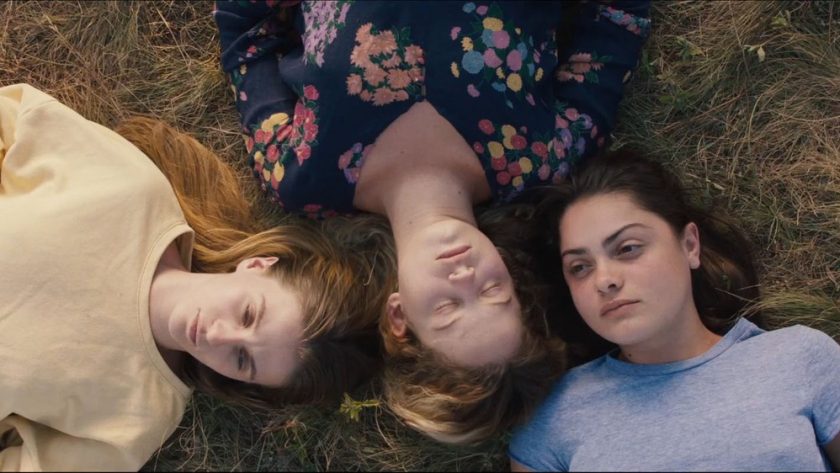Zheyuan Tony Yang reviews the story of three free-spirited women who decide to escape their daily lives and form a gang.
Within the serene valleys of their hometown, three girls await a future that seems as distant to them as the horizon. They pass the time with idle conversation and casual delinquency: imitating hairdressers in a salon and lining up beer bottles to use as target practice for throwing rocks. But, for most of the time, they simply exist. As they lay down upon the grass or sit in the fields and stare into the distance, their eyes fill with an unnamed yearning for something, anything.
Such is the state we find our protagonists in at the beginning of The Hill Where Lionesses Roar (2021), the directorial debut of Luàna Bajrami, the French actor-turned-filmmaker who is previously known for her portrayal of a young maid in the 2019 film, Portrait of a Lady on Fire. Set in a rural village in Bajrami’s birth country of Kosovo, the film follows a teenage trio throughout a summer that begins with the monotonous rhythm of small-town life but transforms into something far more exhilarating. The girls in question are Jeta (Urate Shabani) who is withdrawn, the more outgoing Li (Era Balaj), and the fierce leader of the group Qe (scene-stealing Flaka Latifi). The three friends await university results for the second consecutive year, providing each other company and shelter from their distinctly dysfunctional home lives. The camera follows them from a dance at a local wedding, to various meetings at the abandoned brick house that serves as their headquarters, and their interactions with Zem (Andi Bajgora), a teenage boy who becomes Li’s boyfriend. The lush colours and calming sounds of the surrounding mountainscape combined with the slow, steady tracking shots give a sense of permanence. For better and for worse, it feels like this is how their lives have always been.
Yet this irritable tranquility is quickly shattered when the girls discover that they’ve been rejected from university for another time, their exasperated calls of unfairness flippantly dismissed by the admissions officer. This, alongside a chance encounter with Lena, a child of Kosovo immigrants in France who returns for summer vacation (played by Bajrami herself in a cameo role), makes them further ponder their inability to go beyond the confines of their hometown. This pushes the girls over the edge, and as they shout into the wilderness from the mountaintops, an idea to form a gang enters their minds. So they become the titular “Lionesses of the hill.”
It is here when the film takes a brief yet refreshing detour as it switches genres into a crime thriller, following the trio’s various criminal escapades in a sequence reminiscent of Sofia Coppola’s The Bling Ring (2013). They engage in looting that is seemingly indiscriminate at first, yet quickly escalates in ambition. Starting out by targeting local CD shops and food stands, the trio soon escalates into robbing massive supermarket chains and selling their looted products for cash. Electronic music blares into space previously filled by the natural ambience and time slows down to allow for the girls’ dramatic slow-motion walk. The frenetic energy of this montage, with dazzling streetlights and glowing neon signs adding to an ethereal, dreamy atmosphere, becomes all the more palpable as it stands in contrast with the earlier scenes, Though hardly original in its execution, the scene nevertheless serves as an effective turning point, giving the characters a burst of catharsis and injecting the story with an element of unpredictability.

As the montage comes to a close, the trio spends the rest of the film’s runtime coping with the new reality that they have created for themselves. As Bajrami’s script delves into the fallout of their crimes and newfound wealth, the story begins to buckle under its own narrative ambition. The attempt to simultaneously navigate the shifting dynamics within the group, while exploring each member’s individual trauma and struggles, spreads the plot too thin. Even by the end, we know little about our protagonists outside of their role as a Lioness. That is not to say that the scenes focused on each member are without merit — an extended shot involving Qe’s little sister silently witnessing a heated argument between Qe and their parents comes to mind as particularly moving — but the relationship between the trio remains the most compelling aspect of the film.
Their relationship to each other is built fundamentally on hope: the possibility of leaving behind their stifling village, of building life anew, of exploring what lies beyond the hills. However, this hope proves to be rooted more in youthful idealism than reality as even the girls’ efforts at a luxury getaway turn out to be a weekend trip to a nearby resort. They are trapped not only by circumstance but their perception of themselves and the world. They cannot escape this town for it is all that they’ve ever known.
So the only alternative is to live a fantasy: we watch the girls purchase new bags and clothes, even a new car; we watch them act out an imaginary scenario as rich socialites in an extremely endearing scene; we watch them make waves in a lake and bump shoulders in a nightclub. Bajrami draws out these scenes, prolonging each moment into a small infinity in time. As the film intercuts, these snapshots come together to form the happiest period in the trio’s lives.
But the good times inevitably come to an end, as a highly ambiguous ending leaves the trio’s fate up to interpretation. At the conclusion of this somewhat unfocused but solidly-helmed journey, we are presented with the same image that began this tale of youthful rebellion: three girls standing side by side together.
Watch the trailer for The Hill Where Lionesses Roar here:




